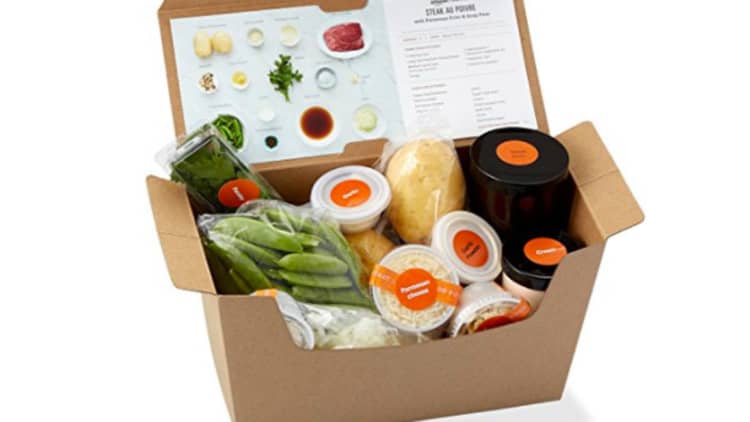
Amazon is testing its own meal kit on a limited basis in Seattle, and we got our hands on one. So we decided to unbox, cook and eat it alongside a similar kit from Blue Apron, which is available in 48 states.
We tried catfish tacos from Amazon and catfish fillets from Blue Apron.
Disclaimer: I am not a confident cook. I order most my groceries online and I don't have a lot of time to cook, so when I do, I want it to be fast, fresh and easy. I was a little intimidated by the prospect of preparing two meals back to back for my hungry producers.
But, for the sake of the story, on to the meal kits.
At first glance, there were a number of similarities. The packaging (lots of it), menu layouts and ingredients were alike. The herbs even come in nearly identical plastic cases:
The Blue Apron box was much larger because it includes three meals for two people. The smaller Amazon offering serves two people one meal.
Right away, that was a bonus for Amazon in my mind. I don't want to commit to making three meals a week, but I like the idea of ordering one meal kit when it suits my schedule. You can order one-off meal kits from Amazon whenever you want (as long as you have an Amazon Fresh membership).
I started with the Amazon kit. First thing I noticed was the prepackaged guacamole and prepped ingredients like already-shucked corn on the cob and sliced jalapenos.
30 minutes after unpacking the box, I had a full meal ready to serve to my hungry producers. They ate -- and enjoyed -- everything.
As for my experience as chef? It felt more like "putting together" tacos than actually cooking a meal, but I appreciated the ease and speed of Amazon's kit.
Next, I moved on to Blue Apron's meal kit.
A lot more prep was required. The carrots needed to be peeled, the garlic had to be diced and the peas had to be shelled. I almost burned the rice and did burn my arm after I threw the carrots into scalding hot oil. The meal was ready 45 minutes after unpacking the box and my producers had room to eat again.
The consensus? They like the Amazon meal, but they loved the Blue Apron meal.
CNBC Producer Deborah Findling said, "even if I hadn't watched you cook both of these, I might have thought -- based on the final result -- that the Blue Apron dish was a bit more labor intensive."
My experience cooking Blue Apron's offering was more stressful, but in the end, more gratifying. I felt like I had actually made -- rather than thrown together -- a decent home-cooked meal. The Blue Apron meal was also a lot healthier than the Amazon one in terms of nutritional value.
Because of those differences, it felt like each kit was for a different kind of consumer. Amazon is selling meal kits for dummies. Blue Apron is selling meal kits for foodies. There may be room for both.
Perhaps the bigger question is: can the meal kit business really take off? While I enjoyed the experience, I'm not sure I'll ever be a regular customer of either offering.
See also: Blue Apron hits all-time low as Amazon suggests it will get into the meal-kit business


